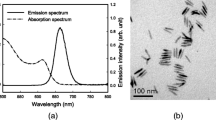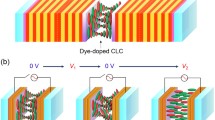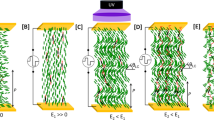Abstract
The present study develops and investigates for the first time a unique spatial continuously tunable cone laser based on a dye-doped cholesteric liquid crystal (DDCLC) film with an LC-birefringence (Δn) gradient. A continuous Δn variation can be generated in a cell by diffusion and self-organization of CLC after four DDCLC mixtures with a discrete variation of Δn are successively injected into an empty cell. Not only the CLC photonic structure but also the lasing wavelength and the cone angle of the obtained conically symmetric emitted lasing ring can be tuned continuously by continuously changing the pumped position of the cell with an Δn gradient. The continuous tunabilities in the lasing wavelength and the corresponding emitted cone angle of the lasing ring are 605.8 → 568.1 nm and 29° → 50°, respectively, within a spatial interval of about 33 mm in the cell.
Similar content being viewed by others
Explore related subjects
Discover the latest articles, news and stories from top researchers in related subjects.Avoid common mistakes on your manuscript.
1 Introduction
Planar cholesteric liquid crystal (CLC) possesses a peculiar structure of one-dimensional photonic crystal (1D PC) with a spatially periodic modulation of refractive index. LC molecules can self-organize and rotate along the helical axis via their interaction with chiral dopants. The helical pitch of such a CLC structure is decided by the helical twisting power (HTP) and the concentration of the chiral material. When the CLC pitch approximates the optical wavelength of the incident light, a selective Bragg reflection band (RB) can be generated. The central wavelength and the bandwidth for this CLCRB can be determined using the formulas λ C = n av p cos θ and Δλ = pΔn, respectively, where n av is the average refractive index of LCs, p is the helical pitch, θ is the angle of incidence from the cell normal (N), and Δn = (n e–n o) (n e and n o are the principal extraordinary and ordinary indices of refraction for the nematic host, respectively) [1].
When a few fluorescent dyes are dissolved in a CLC host (dye-doped CLC or DDCLC) and are excited, spontaneous fluorescence emission is suppressed within the CLCRB and enhanced at the long- and the short-wavelength edges (LWE and SWE) of the CLCRB. Fluorescence photons at the edges of the band can propagate with a very small group velocity and a very large density of photonic states (DOS) via multi-reflection [2]. Based on this optical property, the occurring distributed feedback (DFB) effect can enhance the rates of spontaneous and stimulated emissions in the multi-reflection process, such that a low-threshold lasing emission can be generated at the band’s edges [3–5].
In the recent years, DFB lasing emissions with tunable features based on DDCLC cells have been widely investigated [6–15]. Among these studies, the authors first found a unique color-cone lasing emission (CCLE) based on a DDCLC cell with a single pitch [12] and further studied the tunability for the color band of the CCLE by varying the pitch of the CLC with fixing LC-birefringence (Δn) [13–15]. In addition to the lasing signals commonly observed along N (0° from N, so-called normal lasing), a conically symmetric emitted lasing ring (seen on the screen) with a low-energy threshold comparable with those of normal lasing signals, measured at around 35° from N, is worthy of further investigation because of its uniqueness. There is no such a similar phenomenon that can be found based on laser systems with optical materials different from those of the DDCLC. Furthermore, all past investigations associated with spatially tunable DDCLC lasers demonstrated that the lasing wavelength can be tuned spatially only based on DDCLC lasers with a pitch gradient. The present work, however, offers a first look into a spatial continuously tunable cone laser based on a DDCLC cell with a gradient of LC-birefringence. Experimental results show that not only the lasing wavelength but also the emitted oblique angle for the obtained lasing ring can be tuned continuously from 605.8 nm emitted at 29° to 568.1 nm emitted at 50° by continuously varying the pumped position within a spatial interval of around 33 mm in the cell.
2 Sample preparation and experimental setups
Four kinds of nematic LCs (NLCs) used in the present experiment include LCT-06-99 (Δn = 0.0792 at 20 °C), MDA-03-3970 (Δn = 0.1322 at 20 °C), MDA-04-606 (Δn = 0.2067 at 20 °C), and MDA-98-1602 (Δn = 0.2666 at 20 °C) (all from Merck). Moreover, a left-handed chiral dopant, S811 (from Merck), and a laser dye, Pyrromethene 597 (P597) (from Exciton), are also used. Four DDCLC mixtures with different prescriptions are prepared, namely, 77.8:21.7:0.5 wt% for LCT-06-99:S811:P597, 77.3:22.2:0.5 wt% for MDA-03-3970:S811:P597, 76.6:22.9:0.5 wt% for MDA-04-606:S811:P597, and 74.2:25.3:0.5 wt% for MDA-98-1602:S811:P597. An empty cell with 4 cm-long × 1 cm-wide dimensions is pre-fabricated by combining two indium-tin oxide-coated glass slides separated with 23 μm-thick plastic spacers. Polyvinyl alcohol films are pre-coated individually on the two glass slides of the empty cell and pre-rubbed in an anti-parallel direction for homogeneous alignment. The abovementioned four DDCLC mixtures are injected successively into an empty cell. Afterward, the cell is placed in a clean and opaque specimen box at room temperature for about 4 days to allow the CLCs with originally discrete distribution of Δn enough time to diffuse slowly and self-organize into a perfect planar structure with a continuous distribution of Δn (Δn gradient) extended along the cell from x = 3 to x = 36 mm.
The current study exploits two experimental setups to measure the lasing and the reflection/transmission spectra of a DDCLC cell at a specific oblique angle from N of the cell. The experimental setups and the associated method for measurement can be found in the authors’ previous work [11]. Briefly, the DDCLC cell is excited by a single incident pulse beam (from a Q-switched Nd: YAG SHG pulse laser, wavelength of 532 nm, pulse duration = 8 ns, repetition rate = 10 Hz, pulse energy = E) at an incident angle of around 15° from N. The generated lasing signals (normal lasing signals and lasing ring) are measured at a distance of about 4 cm from the pumped spot on the cell. Both the lasing and the reflection/transmission spectra of the cell are obtained using a fiber-based spectrometer system (Jaz-combo-2, with optical resolution of around 0.9 nm, Ocean Optics).
3 Results and discussion
Both the absorption and the fluorescence emission spectra of 0.5 wt% P597 in the abovementioned four NLCs are pre-measured, and are shown in Fig. 3h. The peaks in the four fluorescence spectra curves are located at almost identical positions at 575 nm. In the present experiment, the lasing does not occur easily below the spectral position of 565 nm because of a strong loss from the re-absorption of generated fluorescence photons at λ ≤ 565 nm.
a A colored reflection pattern obtained by the reflection of one white-light source irradiating on the DDCLC cell with an LC-birefringence gradient. b Gradual blue shifts of the reflection spectrum and the corresponding CLCRB for the DDCLC cell measured as the cell position shifts gradually from x = 3 to x = 36 mm
Figure 1a shows a colored reflection pattern generated by the reflection of a white-light source illuminating on the DDCLC cell with an Δn gradient. The color observed from the right to the left of the reflection pattern of the cell varies gradually from red to green. The CLCRB spectra for 0° measured at randomly selected cell positions from x = 3 to x = 36 mm are displayed in Fig. 1b. Experimental results in Fig. 1b show the formation of a gradient of the bandwidth for the CLCRB because of the Δn gradient formed in the cell, in which the LWEs at different cell positions are pre-designed to be fixed at around 639.9 nm and the SWE blue shifts continuously from 605.8 to 568.1 nm as the cell position detected varies from x = 3 to x = 36 mm. This result reflects the obtained colored reflection pattern of the cell displayed in Fig. 1a
Lasing patterns of the cone lasing emission can be generated when the DDCLC cell is pumped by the incident pulses with E = 8 µJ/pulse at cell positions of x = a 3, b 8, c 15, d 19, e 25, f 29, and g 36 mm, in which corresponding conically symmetric emitted lasing rings with decreasing lasing wavelengths of 605.8 to 568.1 nm (red to green) at increasing oblique angles of 29° to 50° can be obtained
Figure 2a–g displays photographs of seven lasing patterns on the screen after the cell is excited by the incident pumped pulses with an identical energy of E = 8 μJ/pulse at various cell positions of x = 3, 8, 15, 19, 25, 29, and 36 mm, respectively. One conspicuous lasing spot exhibited at 0° and lasing ring exhibited at a specific cone angle (θ ring) can both be observed in each pattern on the screen behind the cell by the naked eye. The unique lasing ring expands, and its color blue shifts as the cell position increases. In other words, not only the lasing wavelength but also the emitted cone angle for the lasing ring signal can be continuously tuned spatially
Detailed lasing emission spectra of the lasing signals for 0° and of the lasing ring for 29°, 32°, 34.6°, 38.8°, 43.6°, 46.6°, and 50°, respectively, measured from the lasing emissions shown in Fig. 2, and the corresponding transmission spectra at the cell positions of x = a 3, b 8, c 15, d 19, e 25, f 29, and g 36 mm. h Absorption and fluorescence emission spectra of the laser dye dissolved in the four kinds of LCs
Detailed lasing emission spectra for the normal lasing signals and lasing ring (Fig. 2) and the corresponding transmission spectra (for 0° and θ ring) at the cell positions of x = 3, 8, 15, 19, 25, 29, and 36 mm are measured and displayed in Fig. 3a–g, respectively. As shown in Fig. 1b, the LWEs of the CLCRB are pre-fixed at 639.9 nm at various cell positions, and the SWE continuously blue shifts with a continuous increase of x. Therefore, according to the photonic band-edge lasing theory for a 1D DFB resonator [1], the experimental result in Fig. 3, where lasing wavelengths for normal lasing signals at the LWE [λ las,LWE(0°)] of CLCRB for 0° at various cell positions are fixed at 639.9 nm and where the lasing wavelength for the normal lasing signal at the SWE [λ las,SWE(0°)] of the CLCRB for 0° continuously blue shifts with a continuous increase of x, is reasonable. Notably, when the cell positions are x = 3, 8, 15, 19, 25, 29, and 36 mm, the measured lasing wavelengths (λ ring) of the lasing rings are 605.8, 601.0, 596.6, 588.7, 580.2, 574.0, and 568.1 nm, respectively, emitted at θ ring = 29°, 32°, 34.6°, 38.8°, 43.6°, 46.6°, and 50°, respectively. The λ ring of the lasing ring emitted at θ ring and obtained at a certain x is located just at the edge-overlapping spectral position of the LWE of the CLCRB for that corresponding oblique angle and the SWE of the CLCRB for 0° at that x. This result reflects that each of the lasing rings obtained at different x of the cell with a gradient Δn is induced by the enhancement of the DOS for the fluorescence with a λ ring based on the abovementioned edge-overlapping effect. The experimental results for variations of λ ring and corresponding θ ring with the cell position displayed in Fig. 3 are summarized in Fig. 4. Based on the blue shift of the above edge-overlapping spectral position with an increase in Δn and the abovementioned explanation for the formation mechanism of the lasing rings, the experimental results in Figs. 2–4, where the λ ring blue shifts from red to green (605.8–568.1 nm) and θ ring enlarges from 29° to 50° with an increase in x from 3 to 36 mm, are reasonable. The result for the tunability of the θ ring of the DDCLC laser is unique and different from the result obtained in the authors’ previous study, which found that the lasing ring only occurs at an invariable oblique angle (around 35°) based on DDCLC cells with different pitches and a fixed Δn or a DDCLC cell with a pitch gradient and a fixed Δn [13–15]. In addition, all previous investigations associated with spatially tunable DDCLC lasers demonstrated that the lasing wavelength can be tuned spatially only based on DDCLC lasers with a pitch gradient [6–11, 13–15]. The current work presents a new spatially tunable DDCLC cone laser based on the mechanism of the edge-overlapping effect, in which not only the lasing wavelength but also the emitted cone angle for the lasing ring can be spatially tuned continuously. Notably, the lasing signal with λ las,LWE(0°) may decay and even disappear in Fig. 3 when the edge-overlapping spectral position blue shifts. This is because the two lasing signals with λ las,SWE(0°) and λ ring both become stronger when the edge-overlapping spectral position is closer to the spectral position of maximum fluorescence emission (around 575 nm), which can induce the depletion of the lasing signal with λ las,LWE(0°) because of its competition with the other two lasing signals with λ las,SWE(0°) and λ ring. The abovementioned spatially continuous variation of the birefringence in the DDCLC cell is not very stable because it can maintain only 3 months. The stability of the birefringence gradient may be improved by replacing the chiral dopants in the CLCs with chiral monomers and then forming polymer networks to stabilize the LC-birefringence gradient of the cell.
4 Conclusion
In conclusion, the present investigation is the first report on the development of a spatially tunable color-cone laser based on a DDCLC cell with an LC-birefringence gradient. Experimental results show that not only the lasing wavelength but also the cone angle of the conically symmetric emitted lasing ring can be tuned continuously by the continuous variation of the pumped position due to the continuous change of the LC-birefringence in the cell. The tunable lasing ring at any position of the cell can be obtained and is demonstrated due to the edge-overlapping effect. The tunable spectral range is from the red to the green region (605.8 → 568.1 nm), and the corresponding tunable emitted oblique angle is from 29° to 50° for the lasing ring within a cell length of 33 mm (x = 3 → 36 mm).
References
P.G. de Gennes, J. Prost, The Physics of Liquid Crystals (Oxford University Press, New York, 1993)
J.P. Dowling, M. Scalora, M.J. Bloemer, C.M. Bowden, J. Appl. Phys. 75, 1896 (1994)
L.S. Goldberg, J.M. Schnur: U.S. Patent 3,771,065, 1973
I.P. Il’chishin, E.A. Tikhonov, V.G. Tishchenko, M.T. Shpak, JETP Lett. 32, 24 (1980)
V.I. Kopp, B. Fan, H.K.M. Vithana, A.Z. Genack, Opt. Lett. 23, 1707 (1998)
H. Finkelmann, S.T. Kim, A. Muñoz, P. Palffy-Muhoray, B. Taheri, Adv. Mater. 13, 1069 (2001)
A. Fuh, T.-H. Lin, J.-H. Liu, F.-C. Wu, Opt. Express 12, 1857 (2004)
A. Chanishvili, G. Chilaya, G. Petriashvili, R. Barberi, R. Bartolino, G. Cipparrone, A. Mazzulla, R. Gimenez, L. Oriol, M. Pinol, Appl. Phys. Lett. 86, 051107 (2005)
Y. Huang, Y. Zhou, S.-T. Wu, Appl. Phys. Lett. 88, 011107 (2006)
M.-Y. Jeong, H. Choi, J.W. Wu, Appl. Phys. Lett. 92, 051108 (2008)
Shih-Hung Lin, Cang-Yi Shyu, Jui-Hsiang Liu, Po-Chih Yang, Ting-Shan Mo, Shuan-Yu. Huang, Chia-Rong Lee, Opt. Express 18, 9496 (2010)
C.-R. Lee, S.-H. Lin, H.-C. Yeh, T.-D. Ji, K.-L. Lin, T.-S. Mo, C.-T. Kuo, K.-Y. Lo, S.-H. Chang, Y.-G. Fuh, S.-Y. Huang, Opt. Express 17, 12910 (2009)
C.-R. Lee, S.-H. Lin, H.-C. Yeh, T.-D. Ji, Opt. Express 17, 22616 (2009)
C.-R. Lee, S.-H. Lin, H.-S. Ku, J.-H. Liu, P.-C. Yang, C.-Y. Huang, H.-C. Yeh, T.-D. Ji, Appl. Phys. Lett. 96, 111105 (2009)
C.-R. Lee, S.-H. Lin, H.-S. Ku, J.-H. Liu, P.-C. Yang, C.-Y. Huang, H.-C. Yeh, T.-D. Ji, C.-H. Lin, Opt. Lett. 35, 1398 (2010)
Acknowledgments
The authors would like to thank the National Science Council of the Republic of China in Taiwan (Contract No. NSC 100-2112-M-006-012-MY3) and the Advanced Optoelectronic Technology Center, National Cheng Kung University, under projects from the Ministry of Education, for the financial support. We greatly appreciate the editorial assistance extended by KGSupport.
Author information
Authors and Affiliations
Corresponding author
Rights and permissions
About this article
Cite this article
Lee, CR., Lin, SH., Lin, JD. et al. Unique spatial continuously tunable cone laser based on a dye-doped cholesteric liquid crystal with a birefringence gradient. Appl. Phys. B 109, 159–163 (2012). https://doi.org/10.1007/s00340-012-5218-z
Received:
Revised:
Published:
Issue Date:
DOI: https://doi.org/10.1007/s00340-012-5218-z








